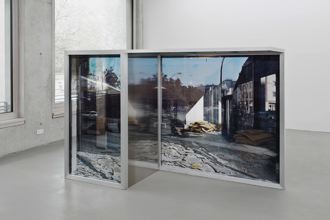
June 12 - June 28, 2015
Sabine Hornig
Checkpoint California, DB Kunsthalle Berlin
No region embodies the American dream as much as California, the Golden State on the Pacific Ocean. Hollywood and Silicon Valley, Malibu and Disneyland. Palms, sea, eternal blue skies. And in the hills of Santa Monica lies Villa Aurora, a »true castle by the sea,« in the words of Thomas Mann, who was often a guest there. As the exile residence of Marta and Lion Feuchtwanger, in the 1940s the house was a meeting point for personalities such as Bertolt Brecht, Fritz Lang, and Charlie Chaplin. The Villa has had a European flavor since time immemorial; a place of transit that brings transatlantic differences and contradictions to the surface.
This tradition continues today. Since 1995, Villa Aurora has housed artists on fellowships working in the visual arts, composition, performance, film, and literature. With »Checkpoint California«, the Villa is now celebrating the 20th anniversary of its founding at the Deutsche Bank KunstHalle. The exhibition shows how California, with its unique atmosphere, has continually inspired fellows to create unique and extraordinary artworks.
The exhibition presents selected works of nine Villa Aurora fellows: Nairy Baghramian, Rosa Barba, Peggy Buth, Sabine Hornig, Christian Jankowski, Michael Just, Philipp Lachenmann, Albrecht Schäfer and Thomas Struth. In different ways, the artists investigate cultural identity, experiences of exile, and phenomena of pop and mass culture. The show is accompanied by a comprehensive program consisting of concerts, films, performances, and talks by alumni.
»Checkpoint California« begins with an ambivalent homage to Hollywood. For her installation »Stars (Politics of Selection — Blanks/Shifter)«, Peggy Buth photographed stars from the Walk of Fame that have not been given to anyone yet. In 183 black-and-white photos and in a projection, she shows baseplates that are unlabeled, covered with graffiti, or that are already weathering. Due to its seriality, the work exposes the merciless mechanisms of the dream factory. At the same time, the stars are like placeholders for unfulfilled hopes.
Thomas Struth’s photographic works »Mountain, Anaheim, California 2013« and »Research Vehicle, Armstrong Flight Research Center, Edwards 2014« shed light on two phenomena that influence our image of California. Disneyland stands for the entertainment industry and the Neil A. Armstrong Flight Research Center for the aerospace industry and high tech. Struth views both as »materialized sculptural testimony to ideas,« in which dreams and utopias become visible.
In the early 1960s, the Beach Boys embodied the carefree, easygoing West Coast feeling. With hits such as »California Girls« and »Surfin’ U.S.A.,« they conjured up the yearnings of middle-class American youth. Michael Just’s series »Al, Dennis, Brian, Carl and Mike performing “Don’t Worry, Baby”« suggests that this dream turned into a nightmare. Some of the band’s members overdosed on drugs and developed psychoses, and some were in touch with sect leader Charles Manson. Just’s paintings are akin to faded black-and-white photos counterpointing the band’s slick, optimistic PR photos.
The gestural brushstroke in Philipp Lachenmann’s two-part installation work »Mirror Series (Brush-stroke)« shimmer in silver. The monochrome surface is like an empty space; the ghetto blaster is silent—at first. Georges Perec’s audio drama »Die Maschine« (1968), which alludes to Goethe’s poem »Wandrers Nachtlied«, can be listened to on headphones. With the combination and juxtaposition of works, Lachenmann opens up discourse about signs and narrative, differences and translation.
Transit, inconstancy, globalized trade, sojourns between worlds—these are the themes of the sculpture »Fluffing the Pillows (Mooring, Silos, Gurney)« by the Iranian artist Nairy Baghramian. Objects titled Moorings are like the hooks on the cranes used to load ship containers, while the amorphous Silos, filled with mineral wool and hardened construction materials, recall sacks used to transport goods.
Sabine Hornig’s photo works play with perception and reality. In her pictures of display window panes that reflect streets and buildings, the interior and exterior overlap. We are brought before the illusion or deception between perception and reflection. In »Spilled Light«, Berlin meets Los Angeles. While the photographs show streets in the German capital, the form of the installation is reminiscent of typical Californian patios with their sliding doors.
Playful and rigidly minimalist, Albrecht Schäfer’s cube chains with letters and colors mark the space like graceful columns rising to the blue Californian sky. However, the hues of the cubes of »Studio Wall« correspond to the light and dark values of the constantly changing light in the studio. Based on a text by the French poet Francis Ponge, »The Notebook of the Pine Wood« twists into the sky on invisible threads. European luggage is not checked-in at »Checkpoint California«.
Marcel Duchamp, Arnold Schönberg, and Frank Lloyd Wright were among those who took part in the »Western Round Table on Modern Art« organized by the California School of Fine Arts in 1949. After the collapse of modern utopias, the people at the round table—at that time exclusively men—discussed the future of art. This symposium inspired Rosa Barba to create her installation »Western Round Table«, in which two projectors communicate with one another.
The power of images is the focus of Christian Jankowski’s film »16 mm Mystery«, which he realized with technical support from special effects experts. With the help of a projector and a mysterious film, the protagonist causes a skyscraper in Los Angeles to collapse. Situated at the interface between concept, art trade, and entertainment industry, »16 mm Mystery« scrutinizes the myths of Hollywood as well as the images that stick in our minds—whether they are from cinema or art, or are real disasters.
Curated by Dr. Hans-Jörg Clement, Prof. Dr. Laurence A. Rickels & Dr. Alexandra von Stosch
Image: SABINE HORNIG, Spilled Light, 2015, Aluminium, perspex, Duraclear, transparent varnish, 185 x 292 x 96 cm, Edition 2 + 1 AP
